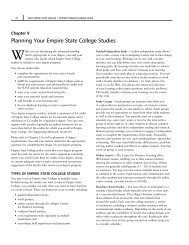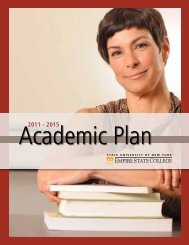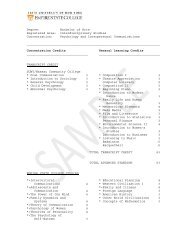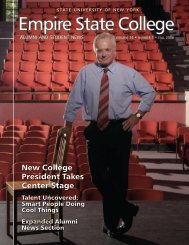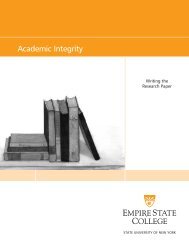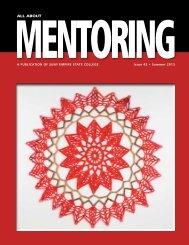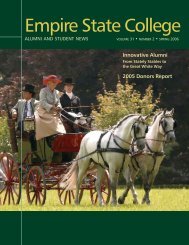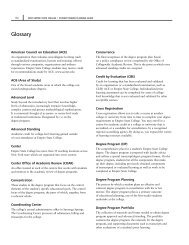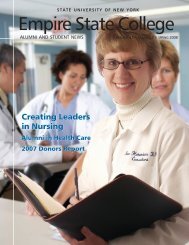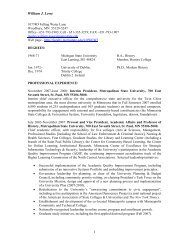All About Mentoring Spring 2011 - SUNY Empire State College
All About Mentoring Spring 2011 - SUNY Empire State College
All About Mentoring Spring 2011 - SUNY Empire State College
Create successful ePaper yourself
Turn your PDF publications into a flip-book with our unique Google optimized e-Paper software.
61<br />
a devoted reader of the left-leaning yet<br />
very respected weekly Proceso, and of the<br />
daily La Jornada. I picked up additional<br />
works recommended by friends, and<br />
family members coming for visits provided<br />
deliveries from Amazon. Life was good! (I’ve<br />
appended a partial bibliography.)<br />
My daily life quickly fell into a pattern. I<br />
was up by 5:30 a.m. and read for a couple<br />
of hours. At least twice a week, I spent<br />
a day “in the field,” either in Yautepec<br />
or Cuernavaca, with an occasional trip<br />
to Mexico, D.F. (the Federal District …<br />
capital). In Yautepec, I retraced walks I had<br />
taken 35 years earlier, covering many of the<br />
nooks and crannies of the municipality. I<br />
took pictures, talked to people, and recorded<br />
observations on a digital recorder. I was<br />
interested in changes that had occurred in<br />
the sugar industry, which had been the heart<br />
of Yautepec’s economy, and the spread of<br />
weekend residences, something that was<br />
just getting started during the ’70s. It wasn’t<br />
that Yautepec was, in any particular sense,<br />
representative of Mexico. The state of<br />
Morelos was substantially better off than all<br />
of its neighbors to the south, and radically<br />
different from the country’s northern states,<br />
where population density was low and<br />
farms could be huge. Yautepec is blessed<br />
with substantial irrigated land and easy<br />
access to urban markets and jobs. It is in<br />
no sense “average,” but it is the place I had<br />
gotten to know pretty well, and I wanted to<br />
get to know it again, at least to the extent I<br />
could in a few brief visits.<br />
During that first month, my home life could<br />
fairly be characterized as monastic. I hadn’t<br />
developed any acquaintances that might<br />
absorb spare hours, and I had lots to read<br />
and think about. In the mornings, when it<br />
was still quite cool, I read on the building’s<br />
flat roof, with a view of Mt. Popocatepetl<br />
off to the east, and much of Cuernavaca<br />
to the west and north. In the middle of<br />
the day my first-floor apartment was cool<br />
enough, and my dining room table doubled<br />
as a desk. Meals were simply prepared on a<br />
two-burner gas stove, and I treated myself<br />
to restaurant meals a couple of evenings a<br />
week. Even that fell into a pattern. Pazole<br />
at El Barco once a week, Sopa de ajo con<br />
dos jeuvos at the Vienese maybe once<br />
every couple of weeks, and perhaps a pizza<br />
occasionally at the Marco Polo, sitting on<br />
the second-floor balcony across from the<br />
cathedral. I know what you’re thinking …<br />
life was hard.<br />
For me, the most amazing part of these<br />
early weeks was: I was doing exactly what<br />
I wanted to do. The books I read were the<br />
ones I wanted and needed to read. The<br />
trips I took were to places I wanted to go.<br />
My writing focused on what I was reading,<br />
seeing and thinking about. I was doing<br />
what I had set out to do: making sense of a<br />
place that had been on the margins of my<br />
consciousness for more than 30 years. It was<br />
only then that I began fully to appreciate<br />
the “down side” of working at <strong>Empire</strong><br />
<strong>State</strong> <strong>College</strong>. I had devoted a career to<br />
responding to the needs and interests of<br />
students. I’d loved doing it, and as a result,<br />
my education was broadened in many<br />
unanticipated ways. I’d developed interests<br />
and even some expertise in adult learning,<br />
in environmental history, in U.S. foreign<br />
policy – all in an effort to anticipate and<br />
respond to my students’ needs. In doing<br />
that, I had willingly sacrificed my currency<br />
in modern Mexican history. In 20 years of<br />
mentoring, I can’t recall a single student<br />
request to study modern Mexico.<br />
The first part of this essay (the second<br />
section will be included in <strong>All</strong> <strong>About</strong><br />
<strong>Mentoring</strong> fall <strong>2011</strong>) briefly explores some<br />
of the changes I encountered and ponders<br />
their implications. I want to emphasize that<br />
I left Mexico in early July 2010 realizing<br />
that I had only scratched the surface. I<br />
also want to express my deep gratitude to<br />
Charlie Goff, director of the Cemanahuac<br />
Educational Community for his friendship<br />
and willingness to share his deep knowledge<br />
of Mexico.<br />
Basic Dimensions of Mexico’s<br />
Change: 1975-2010 Population<br />
In the early 1970s, Mexico’s population<br />
was growing at a rate close to 3.5 percent.<br />
During the intervening years, that rate had<br />
dropped dramatically. By 2010, the U.N.<br />
estimated that its growth rate was closer<br />
to 1 percent. Still, the national population<br />
more than doubled, from 48.2 million in<br />
1970 to 103.3 million in 2005 (INEGI,<br />
Banco de Informacion Economica 1999<br />
cited in Moreno-Brid and Ros, p. 262).<br />
And within the state of Morelos, similarly<br />
dramatic growth had occurred. Its<br />
population had been around 600,000 in<br />
1970. By 2000, it had reached 1.6 million.<br />
The municipality of Yautepec had more<br />
than tripled in size over the same period,<br />
from almost 27,000 to around 84,000.<br />
(These figures are taken from the decennial<br />
censuses of the state, 1970-2000.) The visual<br />
impact of Morelos’s growth is greatest when<br />
you begin to descend into the state on the<br />
highway that connects it to Mexico City.<br />
On that early February morning, I was<br />
stunned to see that the plain where<br />
Cuernavaca used to be nestled in the upperright-hand<br />
corner was now a sea of lights.<br />
This impression was confirmed on my trips<br />
to Yautepec. Where miles of fields had once<br />
separated Cuernavaca “proper” from its<br />
surrounding towns, urban development was<br />
virtually pervasive.<br />
Yautepec, when I lived there, was essentially<br />
a small town. You could get a full view of it<br />
from atop “El Tenayo,” a steep hill within<br />
the city and just south of the Rio Yautepec.<br />
The most striking changes in 2010 involved<br />
the city’s spread toward the west, in the<br />
direction of Cuernavaca. The land there<br />
was not irrigated. It had, in fact, constituted<br />
the village’s original communal land, rocky<br />
and planted in corn or reserved for grazing.<br />
This year, it was quite evident that housing<br />
spread for at least a half mile west of its<br />
previous boundary. A similar pattern was<br />
evident south of El Tenayo. Indeed, in that<br />
direction, two modest and treeless hills just<br />
east of what had been the valley’s major<br />
hacienda, Atlihuayan, were fully developed.<br />
As I walked those hills, a couple stopped me<br />
to try to sell me a plot of land. They assured<br />
me that piped water was plentiful and<br />
electrical service was uninterrupted. And<br />
housing plots were cheap! A couple they<br />
introduced me to invited me into their very<br />
attractive home, with fantastic views of the<br />
surrounding valleys. The man had retired on<br />
the advice of his doctors a few years earlier,<br />
and they had moved to Yautepec from the<br />
Valley of Mexico because the air was clean<br />
and the weather warm. When I walked<br />
these hills in 1974, they were nothing but<br />
scrub. The only inhabitants I encountered<br />
were goats.<br />
Housing developments constituted another<br />
new feature. These had simply not existed<br />
in 1975. There were certainly weekend<br />
suny empire state college • all about mentoring • issue 39 • spring <strong>2011</strong>




